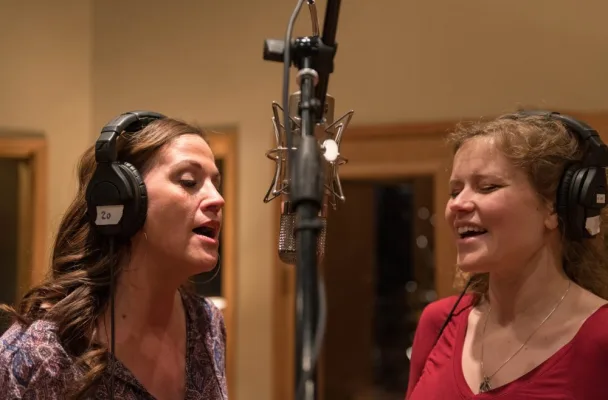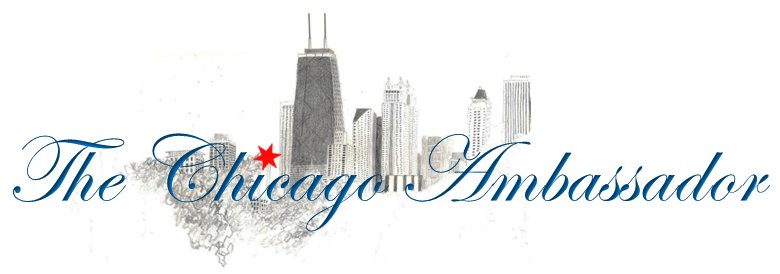New music collaboration highlights Chicago’s Americana history

Kelly Vasquez and Liz Chidester recording ‘On Big Shoulders’ Photo by Tim Brown.
While Chicago’s storied hub of hard work is well known for its hunger and heart, the town’s history is surely shaped as much by its music as its muscle. Late last year, a handful of Chicago’s most skilled musicians gathered to tell that story with the 10 songs that make up the new collaborative album On Big Shoulders that was recently released. Pioneered by Old Town School of Folk Music teacher and old-time musician Matt Brown and GRAMMY-nominated co-producer Liam Davis, the project features guitarist and vocalist Steve Dawson; pedal steel player Brian Wilkie; bassist Aaron Smith; drummer Gerald Dowd; singers Keely Vasquez, Gia Margaret, Elise Bergman, and Liz Chidester; and horn players Anna & Evan Jacobson. Released on Allograph Records, the album pays tribute to Chicago greats like Wilco, Sam Cooke, and Robbie Fulks, who wrote an original song for the record. The group will reunite for a release show on December 2 at the Old Town School of Folk Music with a special guest performance from Barbara Carr.
From the electric blues, gospel, jazz, and folk clubs of its past to the Americana, hip-hop, house music, and writhing post-rock of more recent years, Chicago is a musician’s town—but more precisely, and in the spirit of its indomitable industry, it is a town for the working musician.
In early 2016, an opportunity to showcase these strengths occurred to one transplant making his living in the Windy City. Matt Brown, who since moving to Chicago from Pennsylvania in 2011 has been a teaching artist at the storied Old Town School of Folk Music and sought to highlight the city’s musical prowess. “I was getting more familiar with the recently dubbed ‘Americana’ genre and wanted to make an Americana record using Chicagoland musicians,” Brown says. “I wanted it to be a representation of the strength of Chicago’s current working musicians but also its legacy of being a place where musicians come to make records. It would pay a small tribute to that enormous legacy with fresh renditions of songs already associated with Chicago, along with original compositions inspired by the musicians who have lived and worked here for the last century.”
Bob Chiarito of The Chicago Ambassador recently spoke with Brown, who served as executive producer on the record, about how the project and the legacy of folk and bluegrass (dubbed Americana) music in Chicago which has been largely overlooked.
CA) What was the impetus for this project?
BROWN) I teach at the Old Town School of Folk Music and was preparing for an early country guitar class when I discovered that the Delmore brothers, who were stars at the Grand Ole Opry in the 1930s, had made some of their recordings here in Chicago, which surprised me. Then I discovered that Bill Monroe recorded here. Monroe recorded in the Wrigley Building and the Delmore brothers recorded somewhere near where the Drake hotel is.
So, those ideas were percolating and then I had a separate idea, because there are musicians of high caliber here that could be successful in Nashville or New York or L.A., and although we may not have the number of Americana musicians as they have in Nashville, we have people on that level. I had a dream of assembling an all-star cast of Chicago musicians to make a record that sounded at times like a honky tonk record, and at other times like a jazz or blues record. I decided to put those two ideas together and make an all-star cast of local musicians, giving myself the limitation that every song had to have been either originally recorded here or it was written by a Chicago songwriter.
CA) Very cool. So, you were the one who came up with the song list for the album?
BROWN) For the most part, although for some of the songs I reached out to the musicians themselves. I selected a group of musicians, I think the original number was 6 or 8 although we ended up with 12 on the record. I wanted a Chess Records song and didn’t have a great familiarity with their catalog, especially the deep cuts, so our drummer gave me three ideas and I selected the Barbara Carr song “Shake Your Head.” Steve Dawson, who teaches at the school and sings on seven of the songs suggested that we do a Sam Cooke song and he selected one of his favorites, “I’ll Come Running Back to You,” which is track two. There were a couple others like that. A couple of the tunes were my idea but once I reached out to the band they came up with ideas that really flushed out the repertoire.
CA) The whole concept of Americana music is really just folk and bluegrass, jazz and some blues lumped together, right?
BROWN) Totally. I wanted to make an Americana record but wanted to make one that’s relevant to me and Chicago. In my work as a teacher and my work with the recording academy — the Grammy Organization, I’ve been learning what Americana means. It really is an amalgam of things. At times, to me, it’s really just a way of describing what we used to call country music, but country music no longer is that. If someone put out a record that sounded like early George Jones right now it would probably be marketed as Americana, not country, because it doesn’t sound like Big & Rich.
CA) Do you think the fact that you aren’t originally from Chicago helped to give you a greater appreciation of the folk tradition of Chicago — versus taking it for granted like so many people who are from here?
BROWN) I really do. Partially it’s because I learned a lot from one of my mentors, a guy named Dick Swain. I don’t think he was ever a professional musician, but he was one of my neighbors when I was growing up in Pennsylvania. One of the things he did was learn all the folk songs from wherever he lived, so he started playing all these Pennsylvania folk songs. I’m from there and I did not know a single one of them until he came along, and his idea of learning the songs from the place you live really stuck with me.
CA) A lot of people, especially those outside Chicago, think of Blues when then think of Chicago. But there is a lot of history in Chicago with Folk music. Why do you think it’s been so overlooked?
BROWN) I think it became a really story to tell, the story of the rise of electric blues here, especially given that Chess Records was here and that there are still clubs that exist for blues music. There are still places all over town where you can hear a bluegrass or country band, but it seems like the city really took possession of the blues and identified with that, whereas country and bluegrass became the emblem of Nashville even though in the 1930s and 1940s those musicians came here to record. I don’t entirely know, someone should write a graduate school thesis on this. [Laughter]
CA) Was there any musicians that you wanted to get on this record that weren’t available?
BROWN) No, actually. I got lucky, every one I wanted on the record are on it. There were three musicians that I thought about asking but didn’t, but one of those is involved in a different way. That’s Robbie Fulks. He’s someone I wanted to involve in the project but he had just been nominated for two Grammy’s when I was planning all this and one of his nominations was for a song he wrote — nominated for best American Roots song. I decided that it would be really cool to get him to write a song for the project because I already had three lead singers and added a couple more lead and harmony singers, but what I really needed was songs. Robbie was very gracious and wrote “How Lonely Can You Be.” The other two that I included on my list but never asked were the Irish fiddle player Liz Carroll and bluegrass banjo player Greg Cahill. I didn’t ask them because I wanted to make an Americana record that was more Americana than anything else and if I tried to squeeze in some Irish music or bluegrass music that was more than a cover of a bluegrass song in a different style I felt the album would be too wide ranging and there wouldn’t be a cohesive sound of the rhythm section. I wanted a honky tonk rhythm section that could stray into jazz or blues for a tune but still maintain its integrity.
CA) It sounds like you have ideas that could sustain another record. Any plans for a part two?
BROWN) I would love to do a part two. There were two songs that we had in mind that didn’t make it on the record, and by the time we finished the album my list had grown. I think I have twenty-five or thirty songs waiting for us to try, which can be another three albums. The list keeps growing.
CA) Anything else that people should know?
BROWN) We have a Wilco cover on the album. That’s a band that since I’ve moved here I realize that there is a lot of love for Wilco. We covered the one tune that Jeff Tweedy did not write on their debut album, “It’s Just That Simple.” I had a nice exchange with John Stirratt who wrote the song to get his permission to do the music video, which is just live footage of us making the album sliced together with footage of El trains. John was really excited to see friends of his performing his song and he gave it his blessing, which really meant a lot to us.
CA) You guys have a show scheduled for December 2?
BROWN) Yeah, man. At the Old Town School December 2nd in the big room, we’re having a release concert. It will be 51 years and one day after the school was founded and the day that it was founded, Big Bill Broonzy was there teaching a workshop and our last track is a Big Bill Broonzy cover, “Long Tall Mama,” so that’s exciting. Barbara Carr is coming up from St. Louis and eleven of the twelve musicians on the record will be performing. It will be an amazing night and will be hard to replicate what will happen that night.
For more information about “On Big Shoulders,” and the December 2 release show, click here.
Be sure to “Like” us on Facebook!



Leave a comment